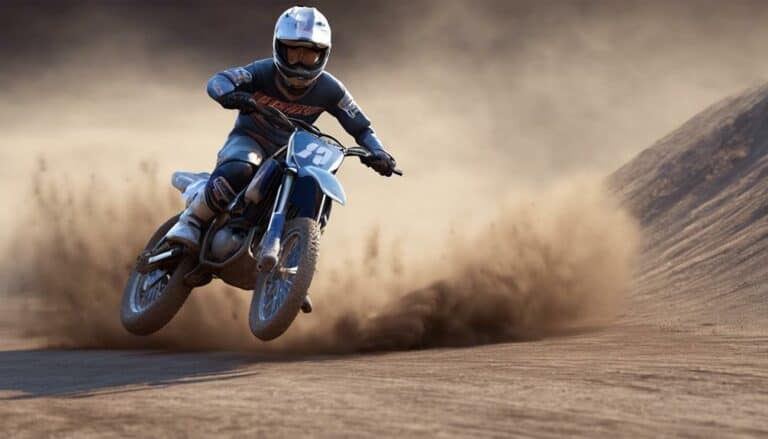When riding dirt trails on your bike, mastering various braking techniques is essential. From adjusting your body position to skillfully using both brakes, each technique plays a critical role in your overall control and performance.
By understanding the nuances of braking drills and corner entry techniques, you'll enhance your ability to handle different terrains and challenges effectively.
Stay tuned to uncover the nuances of these essential skills and take your dirt bike riding to the next level.
Key Takeaways
- Use front brake for stopping power and rear brake for stability
- Balance braking pressure for optimal performance and control
- Practice braking drills to improve muscle memory and skills
- Apply both brakes at corners, initiating braking before entry for stability and speed
The Correct Body Position
When riding a dirt bike, gripping tightly from your ankles to your knees is essential for maintaining control and stability. Your body position plays a vital role in executing effective braking techniques. Align your hips with the pegs to optimize weight distribution.
Standing on the footpegs allows your knees and legs to absorb shock, increasing your ability to control the bike during braking. Avoid sitting down while braking, as this can hinder your braking efficiency. When applying heavy brake pressure, lean back and low over the seat to maintain balance.
Practice braking drills to enhance your skills in controlling both the front and rear brakes. Remember to primarily use the front brake for stopping power while skillfully controlling the rear brake to avoid skidding. Correct body positioning is key to mastering braking techniques, ensuring you ride with confidence and liberation on the dirt track.
Using Both Brakes
Maximize your control and efficiency on the dirt track by mastering the art of utilizing both front and rear brakes in your dirt bike riding adventures. When it comes to braking techniques, using both brakes is key to achieving ultimate performance. The front brake delivers the majority of the stopping power, allowing you to decelerate quickly, while the rear brake contributes to stability and control, preventing skidding and maintaining traction.
Control Your Brakes
Mastering how to precisely control your brakes is fundamental to achieving peak performance in dirt bike riding. To fully utilize your braking system, it is essential to understand when and how to use each brake effectively. When approaching a corner, apply both brakes simultaneously but remember that the front brake provides about 70% of your stopping power. Balancing the braking pressure between the front and rear brakes optimizes stopping power while maintaining stability. When braking hard, use more of the front brake to prevent your rear wheel from lifting off the ground. To prevent sliding and maintain traction, apply the rear brake smoothly. Adjusting your brake ratios based on your experience level and the terrain conditions will enhance your control over the bike. Remember, proper body positioning while braking is vital for stability and control, especially when cornering. Check out the table below for a quick reference guide on brake control techniques.
| Braking Technique | Description |
|---|---|
| Front Wheel Braking | Provides 70% stopping power. |
| Rear Braking | Maintains traction, prevents sliding. |
| Balancing Pressure | Optimizes stopping power and stability. |
| Body Positioning | Vital for stability and control. |
Braking Drills
Enhance your dirt bike riding skills by incorporating targeted braking drills into your practice routine. Braking drills are essential for honing your riding skills, especially when it comes to braking late, mastering engine braking, and controlling the front end of your bike.
Focus on adjusting your weight distribution during these drills to achieve better stability and control, allowing you to navigate corners and obstacles with precision. Integrate cornering drills with braking exercises to enhance your overall performance on varied terrains.
During these drills, train yourself to anticipate obstacles and adjust your braking technique accordingly. By simulating real riding scenarios, you can improve your muscle memory for effective braking in challenging situations.
Braking Corner Entry
For superior control and precision when tackling corners on your dirt bike, mastering the art of braking at corner entry is paramount. Motocross braking demands finesse, especially when approaching a corner. As you navigate the track, remember to apply both front and rear brakes, using two fingers on the lever for best braking control. By initiating braking before reaching the corner entry, you can adjust your speed and prepare for the turn ahead. Balancing the pressure between the front and rear brakes is essential to maintaining stability and traction throughout the corner apex.
A smooth and controlled braking technique not only allows for better positioning but also aids in selecting the ideal line as you navigate the corner. This level of braking mastery at corner entry contributes significantly to faster lap times and overall improved performance on the track. Embrace the challenge of perfecting your braking skills at corner entry, and watch how it enhances your motocross riding experience.
Conclusion
Now that you've learned about the different braking techniques in dirt bike riding, remember that mastering these skills is like conducting a symphony on two wheels. The way you control your brakes can make or break your performance on the track.
So, practice, focus, and feel the thrill of perfecting your braking technique.
Ride like the wind, with the confidence that comes from knowing you have the skills to conquer any terrain.

